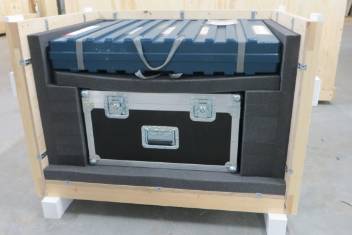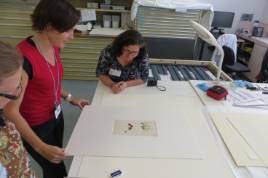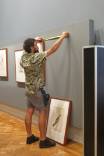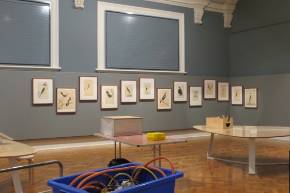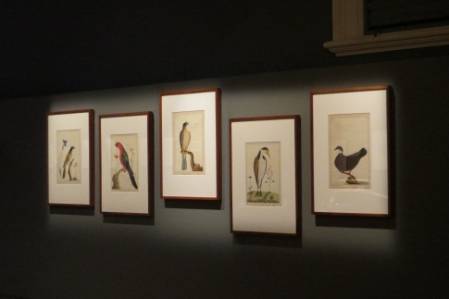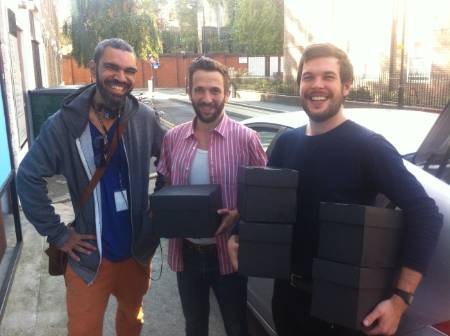by Lisa Di Tommaso (Special Collections Librarian)
There’s no doubt many of you have enjoyed exhibitions of art or artefacts from around the world on a variety of topics. But have you ever considered just how the items brought together from across the globe actually made it to the gallery, and the activity involved? The Library at the Natural History Museum lends many items from its collections to exhibitions, be it to an institution just down the road, or to far-flung places overseas. The process of lending material starts many months in advance and involves a large number of people.
I was fortunate enough to travel to Australia recently, to oversee the delivery and installation of some unique artworks from our First Fleet Collection.
(Above and below) The cases containing the artwork are packed into the bespoke crate, before it is sealed.
The paintings were borrowed by the State Library of New South Wales in Sydney, for their exhibition entitled Artist Colony, which brings together paintings by officers, convicts and other colonists who helped establish the first European settlement in Port Jackson in the early years from 1788.
In order for the State Library to be 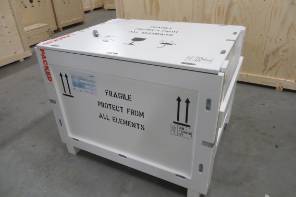 able to borrow the items, a number of negotiations took place with the NHM, confirming the items they wished to borrow, the dates and length of time they would be lent for, the temperature and lighting conditions in which they would be displayed, and any security issues. This always involves a lot of paperwork and many emails back and forth across the globe. Temporary export licences are also arranged at this time. A specialist global shipping company was engaged to assist with the transport of items door to door by road and air.
able to borrow the items, a number of negotiations took place with the NHM, confirming the items they wished to borrow, the dates and length of time they would be lent for, the temperature and lighting conditions in which they would be displayed, and any security issues. This always involves a lot of paperwork and many emails back and forth across the globe. Temporary export licences are also arranged at this time. A specialist global shipping company was engaged to assist with the transport of items door to door by road and air.
As the time to send the items approached, the Museum’s Paper Conservator prepared the material for transport and for display, and wrote detailed reports on the condition of each item. Having a detailed record of the state of the material before it leaves the Library allows us to check the items again after their long journey to make sure no damage occurred en-route. The art was then wrapped very carefully in layers of tissue and then packed securely into what look like large suitcases, lined with protective material to prevent any movement on the journey. The shipping company manufactured a bespoke wooden crate, in which the cases were again packed securely, allowing no room for movement and providing maximum shock absorption.
My job as courier was to travel with that case to Sydney, as far as possible not allowing it out of my sight. The crate and I were collected from the Museum early one morning on a lorry and taken to the company depot where last minute checks and paperwork were completed. We were next driven to the airport, where I oversaw the loading of the crate into a pallet which would then be loaded on to the aircraft. As ‘civilians’ are not allowed on to the tarmac, a company representative oversaw the loading of the pallet onto the plane.
(Above) Checking the conditions of the artwork in Sydney and installiing one of our paintings.
After a quick petrol stop at Dubai and assurances that the crate hadn’t been off-loaded, the journey continued on to Sydney. The crates were collected from the freight cargo area, and we were back on the truck to the State Library.
The items were left for 48 hours to acclimatise to their new environmental conditions before the crate was opened. I worked with the Conservation staff at the State Library to check the condition of each item on arrival, and then to oversee the installation of the paintings on to walls in the display area, and books in to their special cases. I wasn’t fortunate enough to be able to stay for the official opening of the exhibition, but feedback from visitors so far suggests they are thrilled to be able to see artworks which have travelled all the way from London, to be displayed alongside local collections for the first time.
(Above) Exhibition installation in progress and ensuring one of the NHM's volumes is correctly placed in its case.
It takes a huge team effort and plenty of logistics to bring together items for exhibitions – so spare a thought for all the people involved next time you admire an item on loan from another institution!
The final installation!



